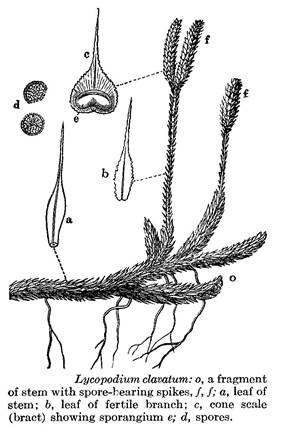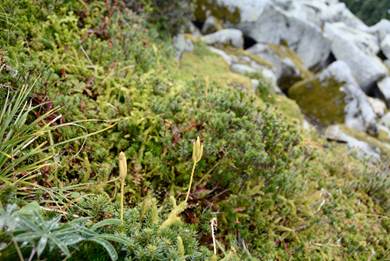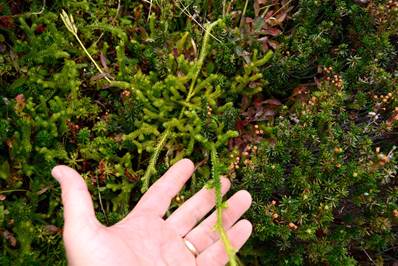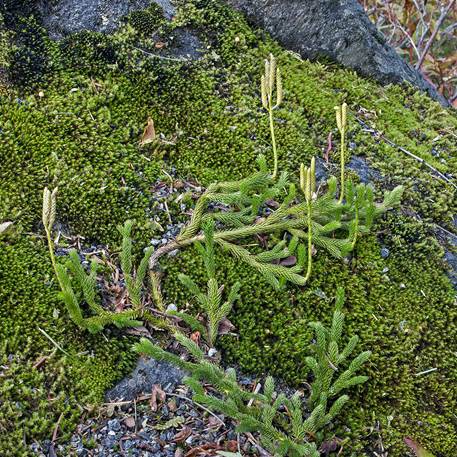In Sweden they form it into bats or baffles, which lie at their doors to clean shoes upon. It restores ropy wine in a few days. Encyclopedia Londinensis, Or, Universal dictionary of the Arts, Sciences, and Literature. Anonymous. 1810.
Running club moss is a Lycopodium, a genus of plants that are flowerless, vascular, terrestrial (some grow in wetlands, however) or epiphytic (grows on other plants). The term vascular means they have xylem and phloem cells that facilitate transport of water and nutrients. In contrast, mosses are not vascular. Running clubmoss has a simple, needle-like or scale like leaves that cover the stems and branches. As a group they are often referred to as ground pines or creeping cedar. Lycopodiuim is from the Greek lukos (wolf) and podion (small foot); and clavatum from the Latin for club-shaped. Other common names include staghorn clubmoss, running ground-pine, and wolf-paw clubmoss.
It has a circumboreal range, reaching as far south as NW California and on the east coast to North Carolina. Lycopodium reproduce asexually by way of spores. In the case of running clubmoss, spores are housed in – what else – a sporangia, which sits erect atop upper branches. Lycopodium have an underground sexual phase that produces gametes and this form alternates in the lifecycle with the spore-producing plant.
So back to basic botany – this means that the gamete (underground) phase has only a haploid (or half) set of chromosomes while the sporophyte (above ground – in pictures) has a diploid (full) set of chromosomes. This alternation of phases is a common strategy for algae, fungi, mosses, ferns, and clubmoss, though it is not easy to observe as the gamete phase is small, even microscopic. This gamete phase will lie dormant for 7 years and then not be sexually mature until 15 years!! They are not photosynthetic and cannot produce their own food, so rely on fungus to provide nutrition. It’s not quite a symbiotic relationship as researchers have not yet found any benefit that is provided to the fungus from the gamete clubmoss.
These are small plants found close to the ground and only 2-6 inches high. The leaves spread from several sides of the vertical stem, giving a round cross-section to the branches (i.e. the branches are not conspicuously flattened in appearance.

The spores of clubmosses have been used in many ways throughout time. North American Indians have applied them to cuts and to treat various skin problems, including eczema and chaffed skin. Running club-moss spores are highly flammable and clubmoss spores were once used by photographers and theatre performers as flash powder.
Because the spores are essentially small, oily spheroids that act like ball bearings, they also were once used in the pharmaceutical industry as a coating for pills and suppositories to prevent them from sticking to each other. Spores are still used in body powders for bed-ridden babies and adults as a means of reducing chaffing.
This plant is still used by the Nuu-chah-nulth and the Nuxalk (B.C. First Nations) as a Christmas decoration in the house. In Ditidaht it is called “causing one to be confused in the woods” as it was thought to disorient anyone who handled it. In several coastal languages – Hesquiat, Haida, and Tlingit it is known as deer’s belt.

I recently came across this plant atop Bandera Mountain (5,240 ft.) growing along the side of a talus field amongst the heather. The sporangia were ready to go, but I didn’t see that any had opened up yet. I sat on an adjacent rock and enjoyed my peanut butter and jelly sandwich and watched the storm clouds slowly envelop nearby Mt. Defiance. It started to hail a few minutes later and I decided it was time to move along, leaving it all to the clubmoss and its buddies.

